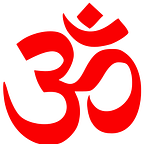The description below from British museum website captures the issue well about the Swastika symbol:
Swastika (Sanskrit svástika) is an ancient symbol of good luck used by many cultures from c. 3000 BC onwards. It remains widely used in India and as a religious symbol in Hinduism, Buddhism and Jainism. In the West, the symbol is stigmatised by its iconic association with Nazi Germany.
A lot has been written to educate people around the world on this — some proofs and points are below — we learn by repetition!
The swastika seal has been found in the Sarasvati-Sindhu civilization (formerly Indus valley civilization), along with other artefacts such as the Pashupati (Shiva) seal. It is a symbol of good health: Su (good) + astika (being) = Svastika (well-being) in Sanskrit. It has been found in other places as well, so ample proof exists that it is an ancient symbol.
The original Nazi symbol was like ∬, elongated double-S or like the double integral symbol. They did not adopt Swastika as their symbol. The shape, color and angle of the Hakenkreuz are also different than that of the ancient swastika symbol.
Hitler modified the double-S symbol by making the two ‘S’ cross each other. He called it Hakenkreuz, meaning ‘Hooked Cross’, in his autobiography ‘Mein Kempf’. He never called it Swastika.
When James Murphy, an English priest translated Mein Kempf to English, he mis-translated Hakenkreuz as Swastika.
People around the world have been amplifying this mis-translation ever since — that is more than 70 years of damage! Not only people, even print or online dictionaries and cutting edge Internet search engines are doing so. Below is a simple demonstration using Google Translate, to drive home the point:
Search for Haken on Google Translate gives Hook as German-to-English meaning as shown below. Anyone can try this by typing ‘google translate’ and ‘haken’ as shown in the image to the left.
Likewise, typing Kreuz gives Cross as the German-to-English meaning.
Now, let’s type Haken Kreuz with a space between the two words — this gives Hook Cross as the meaning. It’s interesting to notice the suggestion, ‘Did you mean hakenkreuz’ as one word!
However, search for Hakenkreuz as one word gives Swastika as the meaning! How does that happen?! Especially, when the tech industry titans take pride in changing the world to be progressive and politically correct! It appears neither natural intelligence nor artificial intelligence is helpful in setting the record straight.
When intellectual honesty and/or the willingness to set the record straight doesn’t prevail, it is a case of intellectual leadership failure, and that leads to more sinister effects at the other extreme — white supremacist groups also use the hakenkreuz as a hate symbol, and everyone calls it swastika; school children over generations are taught the wrong translation by unsuspecting teachers. It’s a suicidal intellectual endeavor, leading to more unintended hate among unintended communities in the long run!
This is not a case of East being insensitive to the West, or trying to promote an alternative perspective. Rather, the hard fact that the right terminology for the Nazi symbol is Hakenkreuz, should be accepted. It is not OK to continue using a mis-translation, when that was never the intended word and never meant to refer to a hate symbol. Any justification of using swastika as a deadhabit due to its popularity or close resemblance to hakenkreuz, or other reasons only serves to promote distrust and unravel hidden religious and political agenda to keep the mis-translation alive. The world should listen to people like Nakagaki who patiently waited in deference to the west for decades before driving the awareness, now that we live in a global village. Going forward we should resolve to only use the word Hakenkreuz to refer to the Nazi hate symbol, in the context of the associated historic evil actions.
There have been outreach efforts with religious and political advocacy groups involved, in creating awareness that Swastika is not the same as Hakenkreuz — the difference has been recognized as this Hindu-Jewish leadership summit declaration shows (reproduced from Hindu American Foundation reporter’s guide to swastika):
“Swastika is an ancient and greatly auspicious symbol of the Hindu tradition. It is inscribed on Hindu temples, ritual altars, entrances, and even account books. A distorted version of this sacred symbol was misappropriated by the Third Reich in Germany, and abused as an emblem under which heinous crimes were perpetrated against humanity, particularly the Jewish people. The participants recognize that this symbol is, and has been sacred to Hindus for millennia, long before its misappropriation.”
However, there is a long way to go for mainstream to catch up. It may have helped thwarting across the board ban in use of the swastika symbol in Europe, forcing law-makers in New York to understand the difference between hakenkreuz and swastika, before tabling a bill to label swastika a hate symbol, and prevailing upon a university’s attempt to throw out a student displaying the hindu swastika with no intent of hate.
This article by True Indology sums it all up — a must read, in my opinion.
